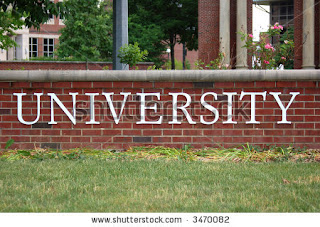Here’s a recipe for success. Start a for-profit corporation
and call it a college. To increase sales --- er enrollments – give it a
prestigious English-sounding name. How about Rumplewick University? Hire “professors”
without the highest degree in their field but with practical on-the-job
training --- accountants, tax advisors, chefs, graphic designers, etc. (They’re
much cheaper than profs with PhDs). Require no research or publishing or
grantsmanship from them. Give no sabbaticals, awards, or other honors. If you
give them a “campus” office, make them share it with other faculty. Assign them
classes with enrollments large enough to meet your profit threshold. Whenever
possible, offer online courses. No need to rent classroom space. No need to
maintain an expensive library, or sports facilities or student activities space.
Build an inviting campus? That’s just a frill. Tell students to forget about
90% of the total social experience of college.
Most important for dear old Rumplewick is this: eliminate
admissions standards. You don’t have a high school diploma or G.E.D.? Not a
problem. No bachelor’s degree? Still not a problem. No SAT scores? Low scores? They’re
just numbers. (After all, not everyone has a 98.6 degree temperature but they
don’t die. Right)? Call your admissions process Open Enrollment. That way
Rumplewick can wrap itself in the democratic tradition that says, “everyone
gets a chance, regardless of their past record.” By democratizing college-level
education, Rumplewick will embrace the Costco-Walmart philosophy which states,
“Everyone can afford us. Just walk through the door.”
Then there’s tuition. If students are desperate enough, you
can charge them more per credit hour than the local community or four-year
college. If you charge the same or less, you’ll get even more enrollees. Where
else are these wannabe students going to go?
Finally, make the courses easy. Real easy. Light reading. Give online
exams. Have students self-grade. They can download term papers off the Internet.
And profs don’t have to really read
them – especially not for grammar, punctuation or spelling. That’s for sissies.
Professors need to understand that students who flunk out are no longer
Rumplewick’s cash cows. Instead, give them social promotions, just like some
public schools. If they paid their fees, if they showed up in person or online
once in a while, if they turned in some written work, what the hell. Pass
‘em.
Of course, caveat
emptor (Let the buyer beware) applies here. A low prestige degree from a
for-profit company may not be accepted by some employers. If your credential is
worthless, have you really gained anything?
One California Assemblyman insists that for-profits earn up
to 90% of their income from federal student loan programs. This means that the
for-profit model is heavily subsidized by taxpayers. Some, Bob Wieckowski
writes, pay their executives annual salaries as high as $41 million. This is
many times what traditional institutions pay their administrators. Bottom line =
There’s Big Money to be made in manufacturing college grads.
You may have problems with my description of for-profits.
The only problem in my mind is that my fictional Rumplewick U. looks uncomfortably like many traditional public and private nonprofit campuses. If you doubt this,
take a look at their continuing or professional ed websites. You can study
everything under the sun on America’s campuses. From astrology and beekeeping
to yoga and zither playing. University extension and continuing education
divisions offer courses, certificates and degrees in a dizzying array of
topics. Many -– perhaps most –- are taught not by college faculty but by
part-timers. Like for-profit instructors, some of these people are very
knowledgeable about their subjects and do a fine job in the classroom. Others
are simply hustling a buck or padding their resume with the title “Professor.”
There is very little quality control at most public and nonprofit private
campuses over these continuing education offerings. Why? Because their primary
purpose is to funnel cash into campus coffers. The legitimate tenured and
tenure-track faculty on traditional campuses pay little attention to the
continuing ed sideshows. But it is that faculty presence alone which prevents the
traditionals from eroding into the for-profit model.
These traditional colleges have become a lot like New York
publishing houses. How can the latter publish the works of award-winning
authors and at the same time peddle the drivel of self-help, chick lit, thriller,
porn, and other dubious genres of books? After all, poetry, literary fiction,
etc. are high on prestige but low on financial return. Their answer: Earnings
from the trash helps us subsidize the treasures. Mainstream universities may
offer degrees in philosophy, religion, physics, history and other lofty
subjects, but many peddle twaddle, as well. Their defense: Some of our most
exalted professors cost us more in salary and benefits than the tuition dollars
their courses yield. Our dreck offerings help offset the costs of these stars.
In my imagination I hear the for-profits telling the
traditional institutions, “If you guys can foist courses of little intellectual
merit on people, we can too, only we’ll make a nice profit for our
shareholders.” My instincts tell me that for-profits are fully capable of
offering good vocational credentials in the many non-academic fields in which
traditional campuses have dealt for generations. Business administration,
nursing, commercial and digital design, film, cuisine, fashion, photography,
and several other specialized trades can probably be taught quite effectively
by well managed for-profits. However, in non-vocational fields such as the
social sciences, humanities, mathematics and sciences – where a degree is not
targeted to an existing career field – traditional universities are likely to
do a better job.
What’s your take on this?
Professor Academe

